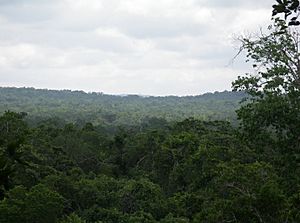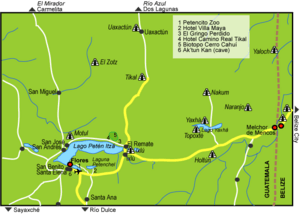El Zotz facts for kids
El Zotz (pronounced "el sots") is an ancient Maya city. It is an archaeological site located in the Petén region of Guatemala. El Zotz is about 20 km (12 mi) west of the famous Maya city of Tikal. It's called El Zotz because many bats live in caves nearby. In the Maya language, "zotz" means "bat."
This large site was important during the Classic Period of Maya history. Many of its ancient buildings and mounds are still covered by jungle. El Zotz was closely connected to other powerful Maya cities like Tikal and Yaxchilan. Some experts believe the royal family of Yaxchilan might have originally come from El Zotz.
The tallest building at El Zotz is a temple about 45 meters (148 ft) high. It's known as "El Diablo," which means "the Devil" in Spanish. People say it got this name because its sides are very steep and dangerous. This area is also a protected natural space, famous for the hundreds of thousands of bats that fly out of the cliffs at sunset.
Contents
What Does "El Zotz" Mean?
The name El Zotz was given to the site in 1977 by an archaeologist named Marco Antonio Bailey. Before that, it was called Dos Aguadas (Two Springs). Bailey likely changed the name to avoid confusion with other places.
The word Zotz means "bat" in several Mayan languages. For example, it's sotz' in Kʼicheʼ Maya and zodz in Yucatec Maya. This name was chosen because a large cave in the El Diablo complex is home to a huge number of bats.
Where is El Zotz Located?
El Zotz is found in the San Miguel La Palotada biotope (a natural area with specific plants and animals). This biotope is part of the larger Maya Biosphere Reserve. It borders the Tikal National Park to the east.
The site itself covers an area of about 0.75 by 0.75 km (0.47 by 0.47 mi). It has many different Maya buildings, both large and small, built in a style common during the Early Classic period. The land has low ridges and valleys, with the highest points around 400 meters (1,300 ft) above sea level. The ground is made of limestone.
The area is covered by tropical moist forest. It also has areas of swamp forest that get flooded during the rainy season. The average temperature is about 27°C (81°F), and it rains a lot, especially from January to April.
Many animals live around El Zotz, including jaguars, pumas, ocelots, Baird's tapirs, and howler monkeys. You might also see Morelet's Crocodiles and ocellated turkeys. Some of these animals are endangered.
History of El Zotz
Even though older pottery pieces have been found, El Zotz grew a lot during the 6th century AD. This was during the Early Classic period. Its location and building style suggest that the powerful city of Tikal influenced this growth. El Zotz's most important time was short, lasting about 100 years. During this time, many palaces and pyramids were built. After this burst of building, the city quickly declined.
The rulers of El Zotz might have started in a nearby site called Bejucal before moving their capital to El Zotz. Ancient Maya writings suggest that El Zotz was founded by enemies of Tikal. This happened when Tikal was going through a weak period. El Zotz also shared its special symbol (called an Emblem Glyph) with Yaxchilan, another important Maya city. It's thought that the royal family of Yaxchilan came from El Zotz.
A stone monument (stela) from Bejucal shows that a powerful general named Siyaj K'ak' was in charge of the king of El Zotz. This general was involved in a big military event in the 4th century AD, supported by the city of Teotihuacan. A special bowl found in Costa Rica has writing that says it was a gift from the king of El Zotz to the king of El Perú. This shows that El Zotz was connected to El Perú, which was a vassal (a smaller state controlled by a larger one) of Calakmul. Calakmul was a big enemy of Tikal.
El Zotz seemed to become prosperous again during the Late Classic period. It had close ties with nearby cities like Tikal and Uaxactun. Even though Tikal influenced El Zotz, El Zotz sided with Tikal's enemy, Calakmul, to gain power in the region. When Tikal became strong again, El Zotz couldn't stand against it.
There's evidence of conflict between El Zotz and Tikal. An earthwork (a large mound of earth) was built to mark the border between their territories. In the 8th century AD, writings at Tikal say that El Zotz and another city, Naranjo, fought against Tikal. This battle happened on February 4, 744 AD. The last known writing about El Zotz describes Tikal attacking the city.
Discovering El Zotz Today
Archaeologists first visited El Zotz because of reports that ancient artifacts were being stolen. Marco Antonio Bailey was the first official visitor in 1977. He created the first map of the site. George F. Andrews wrote the first published report about El Zotz in 1986.
Later, in 1995, the site was remapped. In 2000, some test digs were done. In 2006, more surveys were carried out by archaeologists, including Stephen D. Houston.
The Denver Art Museum returned a carved wooden lintel (a beam over a doorway) that had been stolen from El Zotz. This lintel is very rare and dates back to 550–650 AD. It was taken from Temple 1 in the 1960s. It shows a son of a ruler from Tikal. This important artifact is now in the National Archeology Museum in Guatemala City.
In 2008, a three-year study began at El Zotz. More recent studies using LIDAR (a technology that uses lasers to map the ground) have shown that El Zotz was much larger than first thought. These studies revealed houses, palaces, raised roads, and defensive walls. An archaeologist named Thomas Garrison believes the city's size and population were "grossly underestimated" and could be three or four times larger than previously imagined.
Unfortunately, El Zotz is in danger. It faces threats from not being managed enough, from looting, and from deforestation (cutting down trees). It's also at risk from natural disasters, farming, poaching, and forest fires.
Exploring the Ancient City
El Zotz has at least two main ceremonial areas. The main one is in the center of the site, and the other is called El Diablo. The buildings at El Zotz are very large and well-made, which has helped them last so long. They were built with strong stone blocks, covered with stucco (a type of plaster), and painted in bright colors. Some traces of paint can still be seen today.
Archaeologists found four chultunob (underground chambers) carved into the limestone in the plazas. These were likely used to store water.
The main part of El Zotz is built around a Central Plaza. To the north is the Acropolis, which was probably a palace. To the west is the Plaza of the Five Temples, and to the south is the South Plaza. This central area is on flatter ground, near two natural springs.
The main part of El Zotz has 49 buildings divided into four main groups.
East Group
The East Group has several buildings around a large plaza, including two pyramids that were used for burials on the north side.
The East Causeway is a raised road (called a sacbe by the Maya) that connects the Central Group to the East Group.
Structure M7-1 is a 22.5 meter (74 ft) high temple pyramid. It looks similar to Tikal Temple I. This pyramid once had a wooden lintel that was stolen in the 1960s and later returned to Guatemala in 1998. The lintel shows a human figure holding a ceremonial staff, surrounded by Maya writing.
Structure M7-2 is across the plaza from Structure M7-1. It is 12 meters (39 ft) high.
Central Group
The Central Plaza is surrounded by the Acropolis to the north, a ballcourt to the south, and other platforms and pyramids to the west. Six stone monuments (stelae) and an altar were placed in the Central Plaza.
The Acropolis was likely a palace where important people lived. It has three courtyards and includes several large buildings.
- Structure L7-2 was damaged by looters, but archaeologists found many Early Classic pottery pieces there.
- Structure L7-6 has two wide stairways.
- Structure L7-7 divides two of the courtyards and was probably built later.
Stela 1 is a carved limestone monument in the Central Plaza. It's the only sculpted stela found at the site so far. It has a human figure on the front and Maya writing on the back.
Temple 1 (also called Structure L7-11) is a large pyramid on the northeast side of the Central Plaza. It is 25 meters (82 ft) high and was a funerary temple (a temple used for burials). It has been heavily damaged by looters.
The Ballcourt is on the south side of the Central Plaza. It's quite small compared to the other massive buildings at El Zotz, suggesting it might have been more for show than for actual games.
Five Temples Group
The Plaza of the Five Temples is a wide plaza with two pyramids on the north and south sides. A long temple complex is on the east side. This plaza looks similar to the Plaza of the Seven Temples at Tikal. Two plain stelae are in the center of the plaza, and three more are in front of the temples on the east side.
Structure L7-18 is a small pyramid on the west side of the Central Plaza. It is 7 meters (23 ft) high. It has been damaged by looters, who exposed a vaulted room inside. This room was originally painted red. A looted tomb was found under this temple.
Structure L8-13 is the north pyramid in the Plaza of the Five Temples. It stands 13 meters (43 ft) high. It once held a royal tomb, but it has been completely looted.
The South Causeway is a raised road that goes from the Plaza of the Five Temples south to the South Group.
South Group
The South Group is a large complex that looks like an acropolis, built around an inner courtyard. It has ten or more buildings on a raised platform, covered by thick plants.
El Diablo Complex
El Diablo is about 1 km (0.62 mi) west of the main part of El Zotz. It's the smaller of the two main ceremonial centers. The name El Diablo means "the Devil" in Spanish. It's built on the highest point at El Zotz and can be seen from Temple IV at Tikal. The El Diablo complex also has the famous cave where many bats live, which gave the site its name. This complex is believed to be from the Late Classic period.
The El Diablo hill was shaped by people, with terraces built on its sides. An acropolis with large platforms and at least two plazas was built on top. Looters' tunnels have shown decorated structures inside the El Diablo acropolis, which might be from the Early Classic period.
In July 2010, archaeologists announced the discovery of a royal tomb in the El Diablo complex. It is believed to hold the remains of a king named Chak, who ruled in the late 4th century AD. The king was in his fifties or sixties when he died. His tomb also contained the remains of six young children, aged between 1 and 5 years old.
See also
 In Spanish: El Zotz para niños
In Spanish: El Zotz para niños



